Washington, D.C., the capital of the United States, is not only rich in history and culture but also boasts an impressive network of green spaces and trails perfect for biking enthusiasts. Whether you’re a local commuter, a weekend adventurer, or a tourist looking to explore the city on two wheels, Dc Bike Trails offer something for everyone. These trails, many of which are part of the ambitious Capital Trails Coalition project aiming for an 800-mile regional network, provide scenic routes, connections to key landmarks, and a fantastic way to experience the capital. Let’s explore some of the top DC bike trails that you shouldn’t miss.
1. Metropolitan Branch Trail
 Cyclists and pedestrians enjoy the Metropolitan Branch Trail in Washington, D.C.
Cyclists and pedestrians enjoy the Metropolitan Branch Trail in Washington, D.C.
The Metropolitan Branch Trail (MBT) is rapidly becoming a vital artery in DC’s biking infrastructure. Once fully completed, it will stretch 8 miles from Union Station in DC to Silver Spring, Maryland. Currently, significant portions are open and heavily used by commuters and recreational cyclists alike. This rail-with-trail path follows the old Metropolitan Branch rail line, offering a unique urban biking experience alongside active rail lines, including the Metro Red Line and Amtrak.
Why Bike the Metropolitan Branch Trail?
- Connectivity: The MBT links numerous vibrant and historic neighborhoods such as NoMa, Eckington, Edgewood, and Brookland, making it ideal for exploring different parts of the city.
- Art and Culture: Enjoy the ever-changing murals along the trail and take a break at attractions like Alethia Tanner Park and The Arts Walk at Monroe Street Market, featuring galleries, studios, and eateries.
- Future Expansion: Exciting plans are underway to connect the MBT to the Capital Crescent Trail in Silver Spring, further expanding your biking options.
- Surface: Primarily paved, suitable for road bikes, hybrids, and commuter bikes.
- Difficulty: Generally flat and easy, making it great for all skill levels.
2. Rock Creek Park Trails
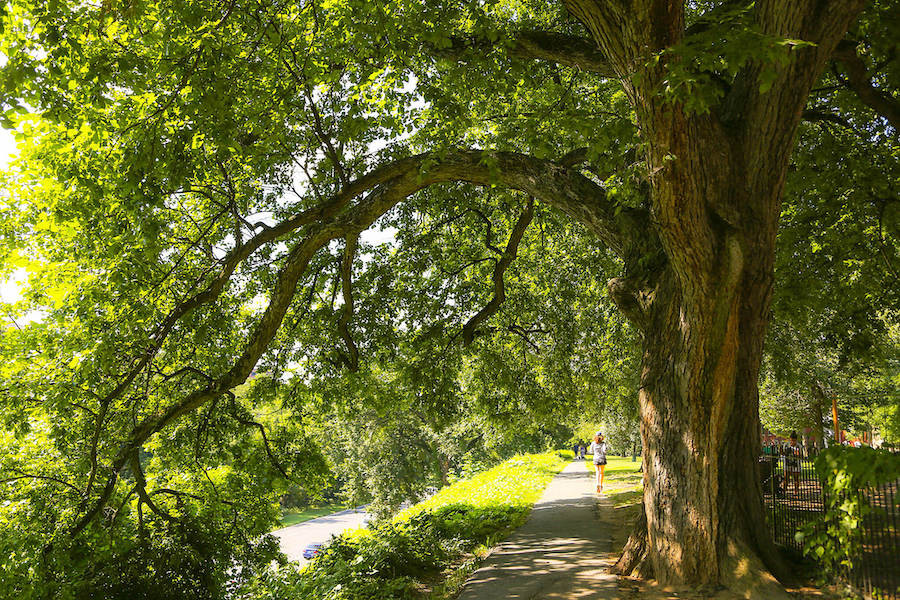 A biker enjoys the paved trails within Rock Creek Park in Washington, D.C.
A biker enjoys the paved trails within Rock Creek Park in Washington, D.C.
As America’s oldest urban national park, Rock Creek Park, established in 1890, provides a sprawling green escape in Northwest DC. Within its 1,700+ acres, cyclists can discover over 32 miles of trails, including an 8.5-mile paved pathway that parallels Beach Drive and Oregon Avenue, loosely following Rock Creek itself.
Why Bike the Rock Creek Park Trails?
- Nature Immersion: Escape the city bustle and immerse yourself in lush greenery and natural landscapes right in the heart of DC.
- Variety of Activities: Rock Creek Park isn’t just for biking; you can also enjoy hiking, picnicking, boating, and even horseback riding.
- Historical Sites: Explore visitor centers like the Peirce Mill dating back to the 1700s and the Old Stone House in Georgetown, adding a historical dimension to your ride.
- Great American Rail-Trail Connection: Rock Creek Park Trails form part of the ambitious Great American Rail-Trail, which will eventually connect DC to Washington State.
- Surface: Mix of paved and unpaved trails. The main paved path is excellent for road and hybrid bikes, while unpaved trails are better suited for mountain bikes.
- Difficulty: Varies. The paved trail is mostly easy to moderate, with some gentle hills. Unpaved trails can be more challenging.
Important Notice: Sections of the southern segment of the paved trail are currently undergoing improvements and may be subject to closures until winter 2024. Check the official project site for the latest updates before planning your ride.
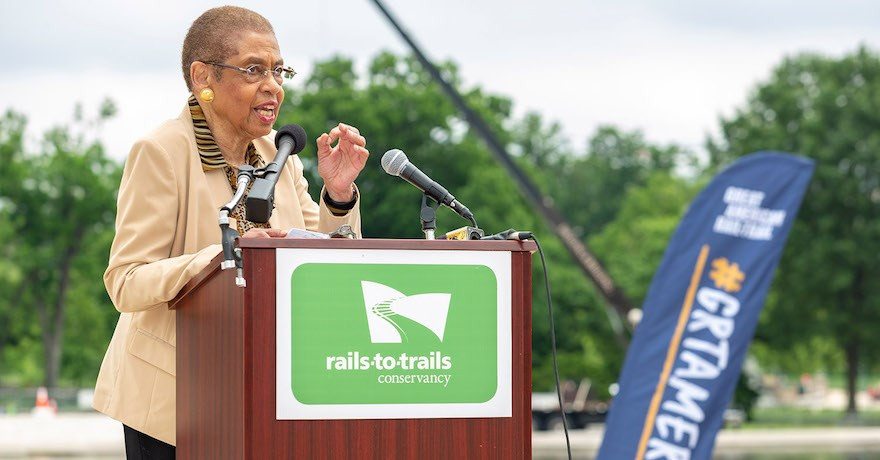 Congresswoman Eleanor Holmes Norton at the launch of the Great American Rail-Trail in Washington, D.C., highlighting the importance of trail networks.
Congresswoman Eleanor Holmes Norton at the launch of the Great American Rail-Trail in Washington, D.C., highlighting the importance of trail networks.
3. National Mall Trails
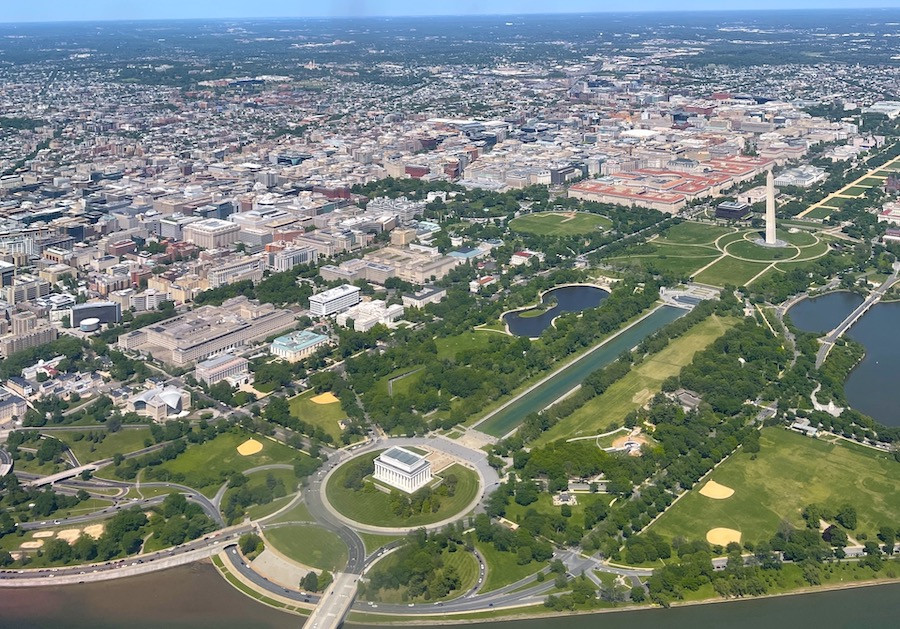 Cyclists ride along the pathways of the National Mall, with iconic monuments in the background.
Cyclists ride along the pathways of the National Mall, with iconic monuments in the background.
No visit to DC is complete without experiencing the National Mall, and what better way to do so than by bike? The National Mall and Memorial Parks offer a network of pedestrian-friendly pathways stretching over 2 miles long and encompassing over 1,000 acres, linking some of the nation’s most iconic landmarks.
Why Bike the National Mall Trails?
- Iconic Sightseeing: Cycle past the Washington Monument, Lincoln Memorial, Martin Luther King, Jr. Memorial, the White House, and the U.S. Capitol Building all in one ride.
- Cultural Hub: Access world-renowned museums like the National Gallery of Art and the Smithsonian Institution complex directly from the trails.
- Cherry Blossom Season: Experience the breathtaking beauty of the National Cherry Blossom Festival in spring as you bike around the Tidal Basin.
- Great American Rail-Trail Connection: The National Mall Trails serve as the eastern anchor of the Great American Rail-Trail.
- Surface: Paved, flat, and very smooth, perfect for all types of bikes and leisurely rides.
- Difficulty: Easy, completely flat and accessible to everyone.
4. Anacostia River Trail
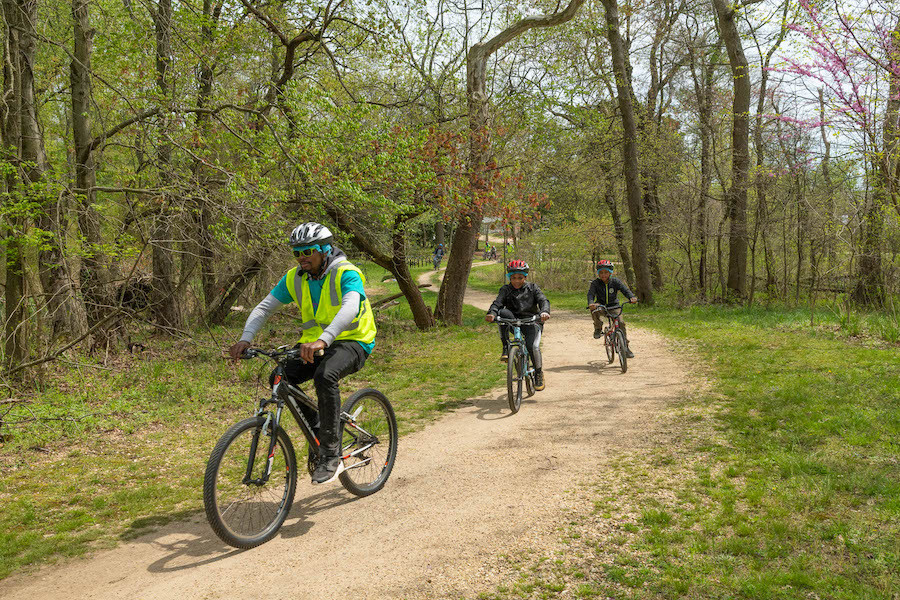 The scenic Anacostia River Trail in Washington, D.C., showcasing natural and urban landscapes.
The scenic Anacostia River Trail in Washington, D.C., showcasing natural and urban landscapes.
The Anacostia River Trail is an evolving 20-mile trail system, with approximately 12 miles currently completed on both sides of the Anacostia River. This trail promises to connect 16 DC neighborhoods, offering a diverse biking experience through wooded areas, marshland, urban settings, and parkland.
Why Bike the Anacostia River Trail?
- Riverfront Views: Enjoy scenic views of the Anacostia River and its revitalized waterfront.
- Recreational Amenities: Access numerous recreational facilities along the trail, including community centers, playgrounds, and sports fields.
- Key Destinations: The trail already connects to major attractions like Nationals Park, Diamond Teague Park, Navy Yard, and Kenilworth Aquatic Gardens. Future expansions will link it to the Tidal Basin and National Mall.
- Trail System Expansion: Connects to the Northwest Branch Trail and Northeast Branch Trail in Maryland, expanding your regional biking adventures.
- Surface: Paved, suitable for road bikes, hybrids, and commuter bikes.
- Difficulty: Generally flat to gently rolling, easy to moderate difficulty.
 A peaceful section of the Anacostia River Trail, surrounded by natural beauty.
A peaceful section of the Anacostia River Trail, surrounded by natural beauty.
5. Klingle Valley Trail
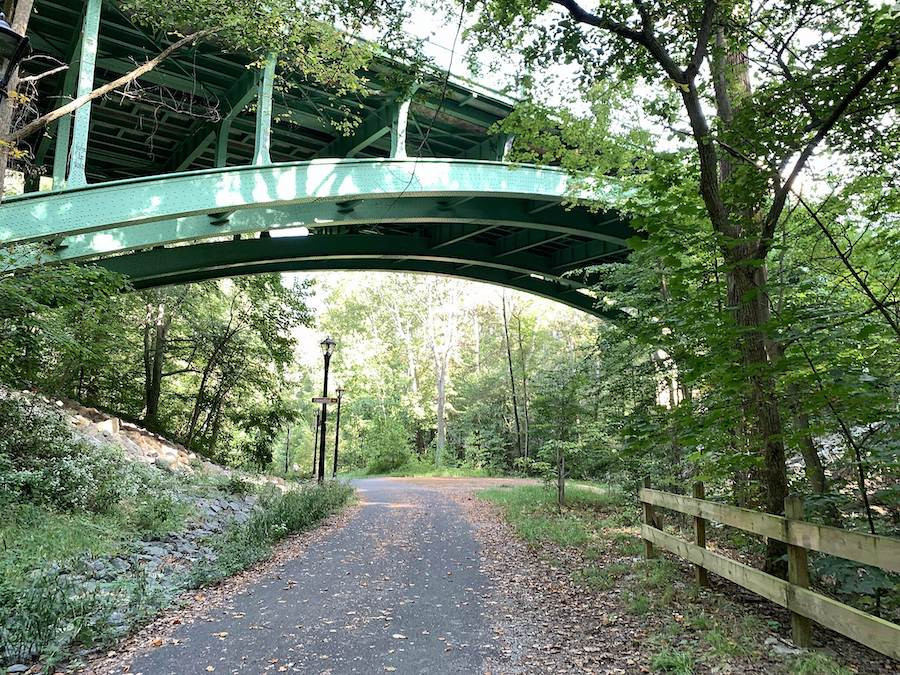 A cyclist enjoys the Klingle Valley Trail, surrounded by trees in a residential area of Washington, D.C.
A cyclist enjoys the Klingle Valley Trail, surrounded by trees in a residential area of Washington, D.C.
The Klingle Valley Trail, a short but charming 0.7-mile trail in Northwest DC, offers a peaceful biking experience in a treelined residential area. Opened in 2017, this paved trail cuts through Klingle Valley, crossing Rock Creek Park just north of the National Zoo.
Why Bike the Klingle Valley Trail?
- Neighborhood Connection: Connects the communities of Cleveland Park, Woodley Park, and Mount Pleasant.
- Tranquil Escape: Provides a quick and easy escape into nature, away from busy city streets.
- Tregaron Conservancy Access: Links to the Tregaron Conservancy, a historic woodland park with additional trails and gardens to explore.
- Restoration Story: The trail project revitalized a long-neglected area, adding ecological value to your ride.
- Surface: Paved, ideal for road bikes, hybrids, and recreational bikes.
- Difficulty: Easy, short and mostly flat.
6. Chesapeake & Ohio Canal National Historical Park (C&O Canal Towpath)
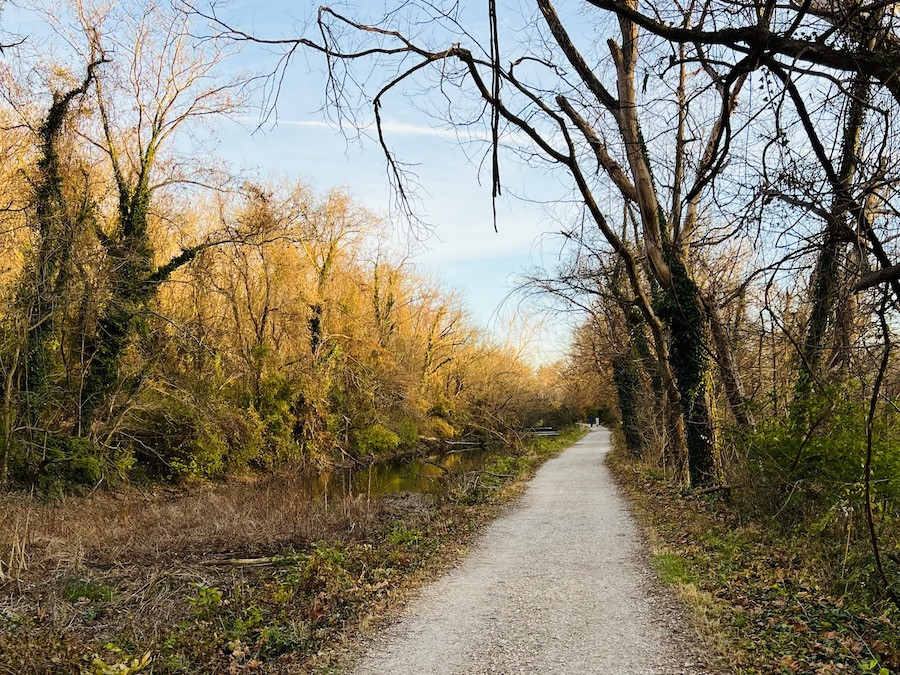 The historic C&O Canal Towpath, a popular trail for biking and history enthusiasts near Washington, D.C.
The historic C&O Canal Towpath, a popular trail for biking and history enthusiasts near Washington, D.C.
Steeped in history dating back to George Washington, the Chesapeake & Ohio Canal National Historical Park offers the 184.5-mile C&O Canal Towpath. Starting near the National Mall and stretching to Cumberland, Maryland, this trail follows a historic canal route that was once a vital commercial corridor.
Why Bike the C&O Canal Towpath?
- Historical Journey: Bike through history, passing original canal features like locks, lock houses, and aqueducts, and learn about its role in the Civil War.
- Long-Distance Adventure: Perfect for multi-day bike trips, offering a continuous route to Cumberland and beyond.
- Great Allegheny Passage Connection: In Cumberland, it connects to the Great Allegheny Passage (GAP), creating a 334.5-mile car-free route to Pittsburgh.
- National Trail Network: Part of the September 11th National Memorial Trail and the Great American Rail-Trail.
- Surface: Primarily packed crushed stone and dirt. Best suited for hybrid bikes, touring bikes, or mountain bikes with wider tires. Can be rough in sections.
- Difficulty: Easy to moderate, mostly flat but long distance can be challenging.
7. Capital Crescent Trail
 The popular Capital Crescent Trail, busy with cyclists and pedestrians in Washington, D.C.
The popular Capital Crescent Trail, busy with cyclists and pedestrians in Washington, D.C.
Serving over a million users annually, the Capital Crescent Trail is a premier DC bike trail. This 11-mile route connects Silver Spring, Maryland, to Georgetown in DC, following a crescent shape with beautiful waterside views, parkland, and cultural landmarks.
Why Bike the Capital Crescent Trail?
- High Usage and Popularity: Experience one of DC’s most beloved and well-maintained trails.
- Scenic Variety: Enjoy diverse scenery, from urban landscapes to natural settings along the Potomac River and C&O Canal Towpath.
- Key Attractions: Pass by the National Zoo and the Kennedy Center, adding cultural stops to your bike ride.
- Rock Creek Park Connection: Connects to Rock Creek Park at both ends (Georgetown and Silver Spring) for extended biking options.
- Great American Rail-Trail Gateway: Serves as a gateway trail to the Great American Rail-Trail in DC.
- Surface: Paved, excellent for road bikes, hybrids, and all types of bikes.
- Difficulty: Easy to moderate, generally flat with some gentle slopes.
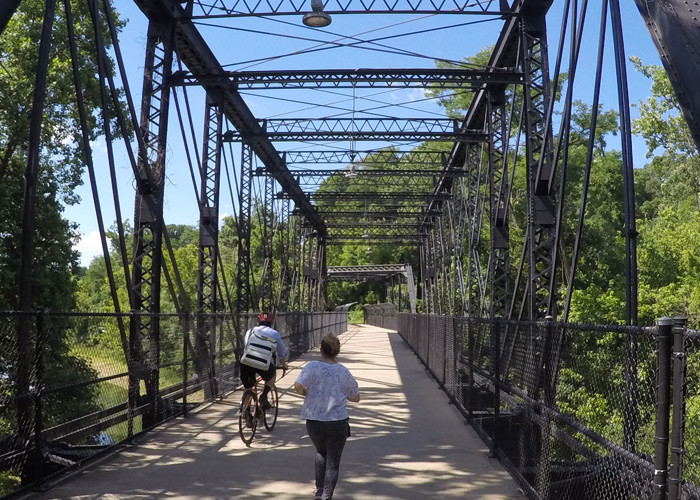 A scenic view along the Capital Crescent Trail, showcasing its lush green surroundings.
A scenic view along the Capital Crescent Trail, showcasing its lush green surroundings.
8. Oxon Run Trail
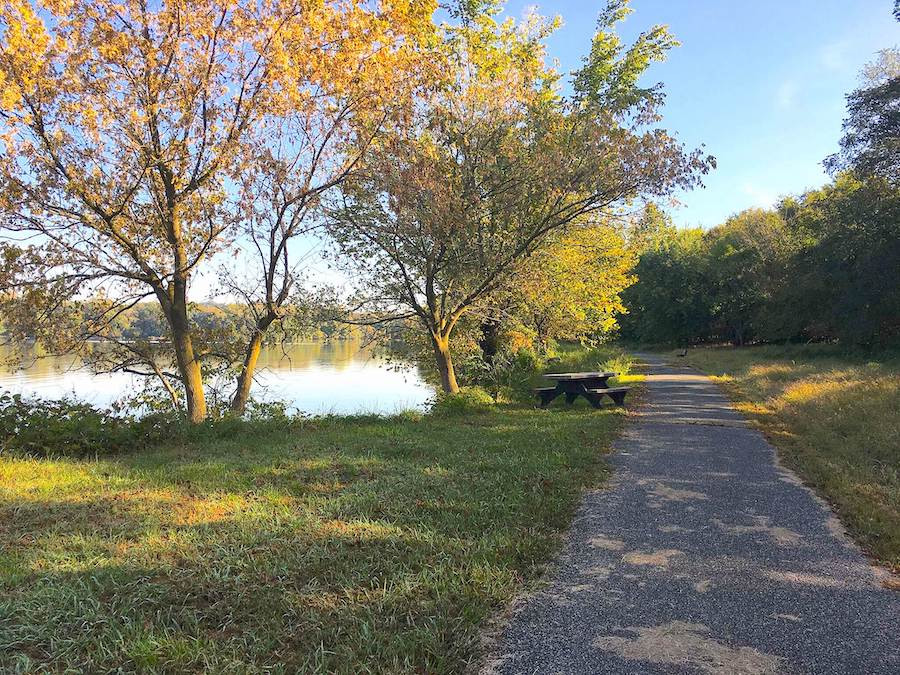 A cyclist on the Oxon Run Trail, enjoying the natural scenery along the tributary.
A cyclist on the Oxon Run Trail, enjoying the natural scenery along the tributary.
Often called a “best-kept secret,” the Oxon Run Trail offers a 3.4-mile ride along Oxon Run tributary in Oxon Run National Parkway. Located in Southeast DC and Prince George’s County, Maryland, this trail provides a valuable outdoor space in an area with fewer trail options.
Why Bike the Oxon Run Trail?
- Local Gem: Discover a less crowded, scenic trail favored by locals.
- Nature and Convenience: Enjoy a natural setting that is easily accessible within the city.
- Recent Upgrades: Benefit from recent rehabilitation with new asphalt, wider paths, and better lighting.
- Future Expansion: Planned expansion of 4.8 miles will connect it to the Oxon Cove Hiker-Biker Trail and the South Capitol Trail, creating a larger network.
- Surface: Paved, suitable for road bikes, hybrids, and commuter bikes.
- Difficulty: Easy to moderate, some sections may have steeper grades. Be aware of a steep downhill section at the southern end.
9. Fort Circle Park Hiker-Biker Trail
 A biker on the Fort Circle Park Hiker-Biker Trail, passing through a wooded and historically significant area.
A biker on the Fort Circle Park Hiker-Biker Trail, passing through a wooded and historically significant area.
The Fort Circle Park Hiker-Biker Trail, a historically significant 7-mile trail, runs through a forested area connecting Civil War-era forts, most of which are now national parks. A large portion of the trail goes through Fort Dupont Park.
Why Bike the Fort Circle Park Hiker-Biker Trail?
- Civil War History: Explore historical sites and learn about the Civil War forts that once defended Washington, D.C.
- Fort Dupont Park: Enjoy the 376-acre Fort Dupont Park, offering nature, history, and recreational activities.
- Rural Feel in the City: Experience a surprisingly rural and wooded environment within the urban area.
- Unique Historical Context: Ride through a landscape that served as a haven for enslaved people seeking freedom during the Civil War.
- Surface: Mostly unpaved, natural surface. Best suited for mountain bikes or sturdy hybrid bikes. Can be overgrown and muddy.
- Difficulty: Moderate. Some hills, natural surface, and road crossings. Hiking or mountain biking recommended.
10. Marvin Gaye Trail
 The Marvin Gaye Trail in Washington, D.C., showcasing its paved path through a vibrant urban park.
The Marvin Gaye Trail in Washington, D.C., showcasing its paved path through a vibrant urban park.
Named in honor of the legendary musician Marvin Gaye, who grew up in DC, the Marvin Gaye Trail is a nearly 2-mile pathway through Marvin Gaye Park, DC’s longest municipal park. This trail connects Minnesota Avenue to 61st Street NE, passing through several neighborhoods and offering access to recreational and community resources.
Why Bike the Marvin Gaye Trail?
- Cultural Significance: Ride a trail named after a music icon and explore the neighborhoods he called home.
- Community Hub: Passes by schools, recreational centers, shopping, and dining, serving as a vital community link.
- Marvin Gaye Park: Explore Marvin Gaye Park, with revitalized green spaces, gardens, and performance areas.
- Local Art: See the colorful Marvin Gaye mosaic at the entrance to Lady Bird Johnson Meadows.
- Surface: Paved, suitable for road bikes, hybrids, and commuter bikes.
- Difficulty: Easy, generally flat and accessible.
Explore More DC Bike Trails
These top 10 DC bike trails are just the beginning. Washington, D.C., and the surrounding region offer a vast network of trails waiting to be explored. Visit TrailLink.com™ to discover even more bike trails in the DC area and plan your next cycling adventure!
